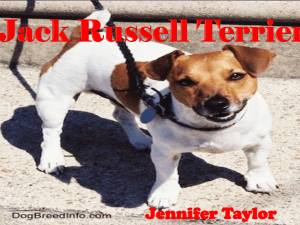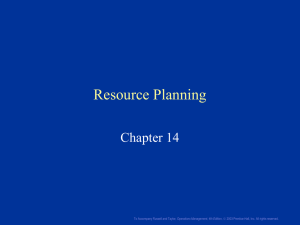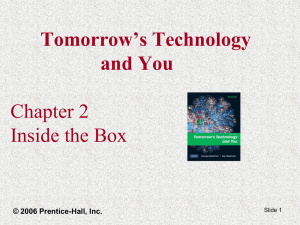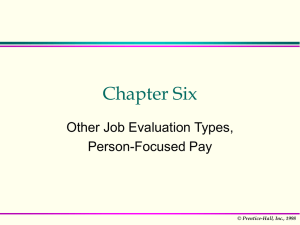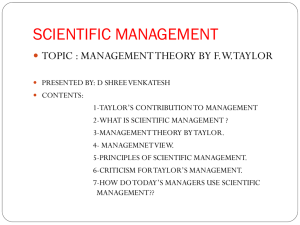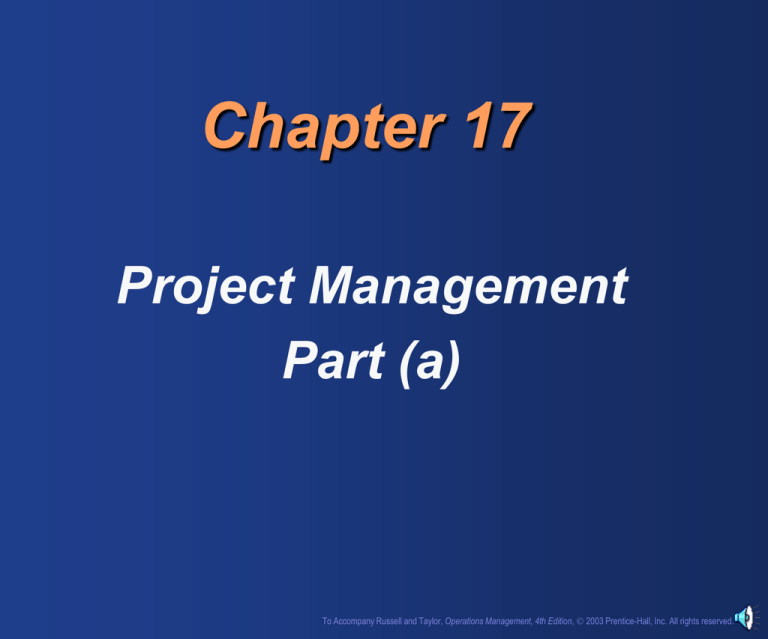
Chapter 17
Project Management
Part (a)
To Accompany Russell and Taylor, Operations Management, 4th Edition, 2003 Prentice-Hall, Inc. All rights reserved.
Elements Of Project
Management
• Project team
– individuals from different departments
within company
• Matrix organization
– team structure with members from
different functional areas depending on
skills needed
• Project manager
– leader of project team
To Accompany Russell and Taylor, Operations Management, 4th Edition, 2003 Prentice-Hall, Inc. All rights reserved.
Project Planning
• Statement of work
– written description of goals, work
& time frame of project
• Activities require labor,
resources & time
• Precedence relationship shows
sequential relationship of project
activities
To Accompany Russell and Taylor, Operations Management, 4th Edition, 2003 Prentice-Hall, Inc. All rights reserved.
Simplified Project
Network
1
Construct forms
2
Pour concrete
3
To Accompany Russell and Taylor, Operations Management, 4th Edition, 2003 Prentice-Hall, Inc. All rights reserved.
•
•
•
•
•
•
•
Elements Of Project
Planning
Define project objective(s)
Identify activities
Establish precedence relationships
Make time estimates
Determine project completion time
Compare project schedule objectives
Determine resource requirements to meet
objective
To Accompany Russell and Taylor, Operations Management, 4th Edition, 2003 Prentice-Hall, Inc. All rights reserved.
Project Control
• Two phases
– 1. planning
– 2. control
• Work breakdown structure (WBS)
– determine subcomponents,
activities & tasks
To Accompany Russell and Taylor, Operations Management, 4th Edition, 2003 Prentice-Hall, Inc. All rights reserved.
Gantt Chart
• Popular tool for project
scheduling
• Graph with bar for representing
the time for each task
• Provides visual display of project
schedule
• Also shows slack for activities
– (amount of time activity can be
delayed without delaying project)
To Accompany Russell and Taylor, Operations Management, 4th Edition, 2003 Prentice-Hall, Inc. All rights reserved.
A Gantt Chart
0
2
Month
4
6
8
10
Activity
Design house and
obtain financing
Lay foundation
Order and receive
materials
Build house
Select paint
Select carpet
Finish work
1
3
5
7
9
Month
To Accompany Russell and Taylor, Operations Management, 4th Edition, 2003 Prentice-Hall, Inc. All rights reserved.
CPM/PERT
• Critical Path Method (CPM)
– DuPont & Remington-Rand (1956)
– deterministic task times
– activity-on-node network construction
• Project Eval. & Review Technique (PERT)
– US Navy, Booz, Allen & Hamilton
– multiple task time estimates
– activity-on-arrow network construction
To Accompany Russell and Taylor, Operations Management, 4th Edition, 2003 Prentice-Hall, Inc. All rights reserved.
The Project Network
Network consists of branches &
nodes
Node
1
2
3
Branch
To Accompany Russell and Taylor, Operations Management, 4th Edition, 2003 Prentice-Hall, Inc. All rights reserved.
Network
Construction
• In AON, nodes represent activities &
arrows show precedence
relationships
• In AOA, arrows represent activities &
nodes are events for points in time
• An event is the completion or
beginning of an activity
• A dummy shows precedence for two
activities with same start & end nodes
To Accompany Russell and Taylor, Operations Management, 4th Edition, 2003 Prentice-Hall, Inc. All rights reserved.
Concurrent
Activities
3
Lay foundation
Lay
foundation
2
Dummy
3
2
Order material
Incorrect
precedence
relationship
4
Order material
Correct
precedence
relationship
To Accompany Russell and Taylor, Operations Management, 4th Edition, 2003 Prentice-Hall, Inc. All rights reserved.
Network Convention: Activity-onArc (AOA)
a
c
a
c
b
a
a
c
c
b
b
b
d
Dummy
activity
To Accompany Russell and Taylor, Operations Management, 4th Edition, 2003 Prentice-Hall, Inc. All rights reserved.
Network Convention: Activity-onNode (AON)
a
b
c
a
b
a
c
c
a
c
b
d
b
To Accompany Russell and Taylor, Operations Management, 4th Edition, 2003 Prentice-Hall, Inc. All rights reserved.
Problem 1
• Management Decision Systems (MDS) is a
consulting company specializing in the
development of decision support systems.
MDS has just obtained the contract to
develop a computer system to assist the
management of a large company in
formulating its capital expenditure plan. The
project leader has developed the list of
activities and immediate predecessors as
shown in the table. Construct the precedence
network (AOA and AON) for this problem.
To Accompany Russell and Taylor, Operations Management, 4th Edition, 2003 Prentice-Hall, Inc. All rights reserved.
Problem 1
Activity
A
B
C
D
E
F
G
H
I
J
Immediate Predecessor
---------------B
A
B
C,D
B,E
F,G
H
To Accompany Russell and Taylor, Operations Management, 4th Edition, 2003 Prentice-Hall, Inc. All rights reserved.
Problem 1 - Solution
Activity-On-Arc (AOA)
2
E
A
H
5
7
1
B
3
4
8
F
D
C
J
G
6
I
To Accompany Russell and Taylor, Operations Management, 4th Edition, 2003 Prentice-Hall, Inc. All rights reserved.
Problem 1 - Solution
Activity-On-Node
A
E
H
J
B
D
I
C
F
G
To Accompany Russell and Taylor, Operations Management, 4th Edition, 2003 Prentice-Hall, Inc. All rights reserved.
Critical Path
• A path is a sequence of connected activities
running from start to end node in network
• The critical path is the path with the longest
duration in the network
• Project cannot be completed in less than the
time of the critical path
To Accompany Russell and Taylor, Operations Management, 4th Edition, 2003 Prentice-Hall, Inc. All rights reserved.
PERT and CPM
• By utilizing project planning and
control techniques (such as PERT and
CPM), a variety of important questions
can be answered, such as:
– When will the project be completed?
– Which activities are most critical
regarding the projects completion time?
– How long can individual tasks be delayed
without causing the project itself to be
delayed?
To Accompany Russell and Taylor, Operations Management, 4th Edition, 2003 Prentice-Hall, Inc. All rights reserved.
PERT and CPM:
Solution Approaches
• Enumerating all Paths in the
Project Network.
• By Calculating Early Start, Early
Finish, Late Start, Late Finish, and
Total Slack.
To Accompany Russell and Taylor, Operations Management, 4th Edition, 2003 Prentice-Hall, Inc. All rights reserved.
Example Project Network
For Building A House
3
Dummy
Lay foundation
0
2
1
3
Design house
and obtain
financing
2
1
4
Order and
receive
materials
Build
house
1
Select
paint
3
6
Finish
work
7
1
1 Selec
t
5 carpe
t
To Accompany Russell and Taylor, Operations Management, 4th Edition, 2003 Prentice-Hall, Inc. All rights reserved.
Solution: All
Possible Paths
A: 1-2-3-4-6-7
3 + 2 + 0 + 3 + 1 = 9 months (36 weeks);
the critical path
B: 1-2-3-4-5-6-7
3 + 2 + 0 + 1 + 1 + 1 = 8 months (32 weeks)
C: 1-2-4-6-7
3 + 1 + 3 + 1 = 8 months (32 weeks)
D: 1-2-4-5-6-7
3 + 1 + 1 + 1 + 1 = 7 months (28 weeks)
To Accompany Russell and Taylor, Operations Management, 4th Edition, 2003 Prentice-Hall, Inc. All rights reserved.
End of
Part (a)
To Accompany Russell and Taylor, Operations Management, 4th Edition, 2003 Prentice-Hall, Inc. All rights reserved.
Chapter 17
Project Management
Part (b)
To Accompany Russell and Taylor, Operations Management, 4th Edition, 2003 Prentice-Hall, Inc. All rights reserved.
Definitions
• Early Start (ES), the earliest time
an activity can start
• Early Finish (EF), the earliest time
an activity can finish
EF = ES + Activity Time
To Accompany Russell and Taylor, Operations Management, 4th Edition, 2003 Prentice-Hall, Inc. All rights reserved.
Definitions
• Late Start (LS), the latest time the
activity can finish and not delay
the project
• Late Finish (LF), the latest time
the activity can finish and not
delay the project
LS = LF – Activity Time
To Accompany Russell and Taylor, Operations Management, 4th Edition, 2003 Prentice-Hall, Inc. All rights reserved.
Definitions
• Total Slack (TS) or Slack Time is:
TS = LS – ES
or
TS = LF – EF
To Accompany Russell and Taylor, Operations Management, 4th Edition, 2003 Prentice-Hall, Inc. All rights reserved.
Definitions
• A path is a sequence of connected
activities running from start to end
node in network
• The Critical Path (CP) is the path with
the longest duration in the network.
Also, it is the path in the network along
which the activities have a zero total
slack value.
• Project cannot be completed in less
than the time of the critical path
To Accompany Russell and Taylor, Operations Management, 4th Edition, 2003 Prentice-Hall, Inc. All rights reserved.
Computing Algorithm
• Forward Pass: Calculate the Early
Finish Time for Each Activity
• Backward Pass: Calculate the
Late Start for Each Activity
• Determine the Total Slack for
Each Activity
• Identify the Critical Path for the
project
To Accompany Russell and Taylor, Operations Management, 4th Edition, 2003 Prentice-Hall, Inc. All rights reserved.
Problem 2
• For the given activities and their
immediate predecessors, draw the
precedence diagram. Then find the
early start, early finish, late start, and
late finish for each activity. Also,
determine the length of the critical path
and the activities along the critical
path.
To Accompany Russell and Taylor, Operations Management, 4th Edition, 2003 Prentice-Hall, Inc. All rights reserved.
Problem 2
Activity Immediate Predecessors Expected Time (Days)
A
-----4
B
A
12
C
A
3
D
B
6
E
B
4
F
B, C
3
G
D
3
H
E, F
2
I
G
5
J
H
3
K
I, J
1
To Accompany Russell and Taylor, Operations Management, 4th Edition, 2003 Prentice-Hall, Inc. All rights reserved.
Problem 2 – Precedence
Diagram (AON)
B
D
A
E
C
G
H
I
K
J
F
To Accompany Russell and Taylor, Operations Management, 4th Edition, 2003 Prentice-Hall, Inc. All rights reserved.
Problem 2 – Precedence
Diagram (AOA)
3
1
5
7
2
9
4
6
10
8
To Accompany Russell and Taylor, Operations Management, 4th Edition, 2003 Prentice-Hall, Inc. All rights reserved.
A
A
B
C
D
E
F
G
H
I
J
K
IP ET ES EF LS LF TS
---- 4
A 12
A
3
B
6
B
4
B,C 3
D
3
E,F 2
G
5
H
3
I, J 1
To Accompany Russell and Taylor, Operations Management, 4th Edition, 2003 Prentice-Hall, Inc. All rights reserved.
A
A
B
C
D
E
F
G
H
I
J
K
IP ET ES EF LS LF TS
---- 4
0
A 12
A
3
B
6
B
4
B,C 3
D
3
E,F 2
G
5
H
3
I, J 1
To Accompany Russell and Taylor, Operations Management, 4th Edition, 2003 Prentice-Hall, Inc. All rights reserved.
A
A
B
C
D
E
F
G
H
I
J
K
IP ET ES EF LS LF TS
---- 4
0
4
A 12
A
3
B
6
B
4
B,C 3
D
3
E,F 2
G 5
H 3
I, J 1
To Accompany Russell and Taylor, Operations Management, 4th Edition, 2003 Prentice-Hall, Inc. All rights reserved.
A
A
B
C
D
E
F
G
H
I
J
K
IP ET ES EF LS LF TS
---- 4
0 4
A 12 4
A 3
B
6
B
4
B,C 3
D 3
E,F 2
G 5
H 3
I, J 1
To Accompany Russell and Taylor, Operations Management, 4th Edition, 2003 Prentice-Hall, Inc. All rights reserved.
A
A
B
C
D
E
F
G
H
I
J
K
IP ET ES EF LS LF TS
---- 4
0
4
A 12 4 16
A
3
B
6
B
4
B,C 3
D
3
E,F 2
G 5
H 3
I, J 1
To Accompany Russell and Taylor, Operations Management, 4th Edition, 2003 Prentice-Hall, Inc. All rights reserved.
A
A
B
C
D
E
F
G
H
I
J
K
IP ET ES EF LS LF TS
---- 4
0 4
A 12 4 16
A 3
4 7
B
6
B
4
B,C 3
D 3
E,F 2
G 5
H 3
I, J 1
To Accompany Russell and Taylor, Operations Management, 4th Edition, 2003 Prentice-Hall, Inc. All rights reserved.
A
A
B
C
D
E
F
G
H
I
J
K
IP ET ES EF LS LF TS
---- 4
0 4
A 12 4 16
A 3
4 7
B
6 16 22
B
4
B,C 3
D 3
E,F 2
G 5
H 3
I, J 1
To Accompany Russell and Taylor, Operations Management, 4th Edition, 2003 Prentice-Hall, Inc. All rights reserved.
A
A
B
C
D
E
F
G
H
I
J
K
IP ET ES
---- 4
0
A 12 4
A
3
4
B
6 16
B
4 16
B,C 3
D
3
E,F 2
G 5
H 3
I, J 1
EF LS LF TS
4
16
7
22
20
To Accompany Russell and Taylor, Operations Management, 4th Edition, 2003 Prentice-Hall, Inc. All rights reserved.
A IP ET ES EF LS LF TS
A ---- 4
0
4
B A 12 4 16
C A
3
4
7
D B
6 16 22
E B
4 16 20
F B,C 3 16 or
7?
G D
H E,F
I G
J H
K I, J
3
2
5
3
1
To Accompany Russell and Taylor, Operations Management, 4th Edition, 2003 Prentice-Hall, Inc. All rights reserved.
A
A
B
C
D
E
F
G
H
I
J
K
IP ET ES EF LS LF TS
---- 4
0 4
A 12 4 16
A 3
4 7
B
6 16 22
B
4 16 20
B,C 3 16 19
D 3
E,F 2
G 5
H 3
I, J 1
To Accompany Russell and Taylor, Operations Management, 4th Edition, 2003 Prentice-Hall, Inc. All rights reserved.
A
A
B
C
D
E
F
G
H
I
J
K
IP ET ES
---- 4
0
A 12 4
A
3
4
B
6 16
B
4 16
B,C 3 16
D
3 22
E,F 2 20
G 5 25
H 3 22
I, J 1
EF LS LF TS
4
16
7
22
20
19
25
22
30
25
To Accompany Russell and Taylor, Operations Management, 4th Edition, 2003 Prentice-Hall, Inc. All rights reserved.
A
A
B
C
D
E
F
G
H
I
J
K
IP ET ES EF LS LF TS
---- 4
0 4
A 12 4 16
A 3
4 7
B
6 16 22
B
4 16 20
B,C 3 16 19
D 3 22 25
E,F 2 20 22
G 5 25 30
H 3 22 25
I, J 1 30 31
To Accompany Russell and Taylor, Operations Management, 4th Edition, 2003 Prentice-Hall, Inc. All rights reserved.
Problem 2 – Precedence
Diagram (AOA)
3
1
5
7
2
9
4
6
10
8
To Accompany Russell and Taylor, Operations Management, 4th Edition, 2003 Prentice-Hall, Inc. All rights reserved.
A
A
B
C
D
E
F
G
H
I
J
K
IP ET ES EF LS LF TS
---- 4
0 4
A 12 4 16
A 3
4 7
B
6 16 22
B
4 16 20
B,C 3 16 19
D 3 22 25
E,F 2 20 22
G 5 25 30
H 3 22 25
I, J 1 30 31
31
To Accompany Russell and Taylor, Operations Management, 4th Edition, 2003 Prentice-Hall, Inc. All rights reserved.
A
A
B
C
D
E
F
G
H
I
J
K
IP ET ES EF LS LF TS
---- 4
0 4
A 12 4 16
A 3
4 7
B
6 16 22
B
4 16 20
B,C 3 16 19
D 3 22 25
E,F 2 20 22
G 5 25 30
H 3 22 25
I, J 1 30 31 30 31
To Accompany Russell and Taylor, Operations Management, 4th Edition, 2003 Prentice-Hall, Inc. All rights reserved.
A
A
B
C
D
E
F
G
H
I
J
K
IP ET ES EF LS
---- 4
0 4
A 12 4 16
A 3
4 7
B
6 16 22
B
4 16 20
B,C 3 16 19
D 3 22 25
E,F 2 20 22
G 5 25 30
H 3 22 25
I, J 1 30 31 30
LF TS
30
30
31
To Accompany Russell and Taylor, Operations Management, 4th Edition, 2003 Prentice-Hall, Inc. All rights reserved.
A
A
B
C
D
E
F
G
H
I
J
K
IP ET ES
---- 4
0
A 12 4
A
3
4
B
6 16
B
4 16
B,C 3 16
D
3 22
E,F 2 20
G 5 25
H 3 22
I, J 1 30
EF
4
16
7
22
20
19
25
22
30
25
31
LS LF TS
25 30
27 30
30 31
To Accompany Russell and Taylor, Operations Management, 4th Edition, 2003 Prentice-Hall, Inc. All rights reserved.
A
A
B
C
D
E
F
G
H
I
J
K
IP ET ES
---- 4
0
A 12 4
A
3
4
B
6 16
B
4 16
B,C 3 16
D
3 22
E,F 2 20
G 5 25
H 3 22
I, J 1 30
EF
4
16
7
22
20
19
25
22
30
25
31
LS LF TS
25
27
25 30
27 30
30 31
To Accompany Russell and Taylor, Operations Management, 4th Edition, 2003 Prentice-Hall, Inc. All rights reserved.
A
A
B
C
D
E
F
G
H
I
J
K
IP ET ES EF LS LF TS
---- 4
0 4
A 12 4 16
A 3
4 7
B
6 16 22
22
B
4 16 20
25
B,C 3 16 19
25
D 3 22 25 22 25
E,F 2 20 22 25 27
G 5 25 30 25 30
H 3 22 25 27 30
I, J 1 30 31 30 31
To Accompany Russell and Taylor, Operations Management, 4th Edition, 2003 Prentice-Hall, Inc. All rights reserved.
A IP ET ES EF LS LF TS
A ---- 4
0
4
16,
B A 12 4 16
21,
or
22?
C A
D B
E B
F B,C
G D
H E,F
I G
J H
K I, J
3
6
4
3
3
2
5
3
1
4
16
16
16
22
20
25
22
30
7
22
20
19
25
22
30
25
31
16
21
22
22
25
25
27
30
22
22
25
25
25
27
30
30
31
To Accompany Russell and Taylor, Operations Management, 4th Edition, 2003 Prentice-Hall, Inc. All rights reserved.
A
A
B
C
D
E
F
G
H
I
J
K
IP ET ES EF LS LF TS
---- 4
0 4
A 12 4 16 4 16
A 3
4 7 19 22
B 6 16 22 16 22
B 4 16 20 21 25
B,C 3 16 19 22 25
D 3 22 25 22 25
E,F 2 20 22 25 27
G 5 25 30 25 30
H 3 22 25 27 30
I, J 1 30 31 30 31
To Accompany Russell and Taylor, Operations Management, 4th Edition, 2003 Prentice-Hall, Inc. All rights reserved.
A
A
B
C
D
E
F
G
H
I
J
K
IP ET ES EF LS LF TS
---- 4
0 4
4
A 12 4 16 4 16
A 3
4 7 19 22
B 6 16 22 16 22
B 4 16 20 21 25
B,C 3 16 19 22 25
D 3 22 25 22 25
E,F 2 20 22 25 27
G 5 25 30 25 30
H 3 22 25 27 30
I, J 1 30 31 30 31
To Accompany Russell and Taylor, Operations Management, 4th Edition, 2003 Prentice-Hall, Inc. All rights reserved.
A
A
B
C
D
E
F
G
H
I
J
K
IP ET ES EF LS LF TS
---- 4
0 4 0 4
A 12 4 16 4 16
A 3
4 7 19 22
B 6 16 22 16 22
B 4 16 20 21 25
B,C 3 16 19 22 25
D 3 22 25 22 25
E,F 2 20 22 25 27
G 5 25 30 25 30
H 3 22 25 27 30
I, J 1 30 31 30 31
To Accompany Russell and Taylor, Operations Management, 4th Edition, 2003 Prentice-Hall, Inc. All rights reserved.
A IP ET ES EF LS LF TS
A ---- 4
0
4
0
4 4-4
=0
or
0-0
=0
B A 12
C A
3
D B
6
E B
4
F B,C 3
G D
3
H E,F 2
I G
5
J H
3
K I, J 1
4
4
16
16
16
22
20
25
22
30
16
7
22
20
19
25
22
30
25
31
4 16
19 22
16 22
21 25
22 25
22 25
25 27
25 30
27 30
30 31
To Accompany Russell and Taylor, Operations Management, 4th Edition, 2003 Prentice-Hall, Inc. All rights reserved.
A
A
B
C
D
E
F
G
H
I
J
K
IP ET ES EF LS LF
---- 4
0 4 0 4
A 12 4 16 4 16
A 3
4 7 19 22
B 6 16 22 16 22
B 4 16 20 21 25
B,C 3 16 19 22 25
D 3 22 25 22 25
E,F 2 20 22 25 27
G 5 25 30 25 30
H 3 22 25 27 30
I, J 1 30 31 30 31
TS
0
0
15
0
5
6
0
5
0
5
0
To Accompany Russell and Taylor, Operations Management, 4th Edition, 2003 Prentice-Hall, Inc. All rights reserved.
End of
Part (b)
To Accompany Russell and Taylor, Operations Management, 4th Edition, 2003 Prentice-Hall, Inc. All rights reserved.
Chapter 17
Project Management
Part (c)
To Accompany Russell and Taylor, Operations Management, 4th Edition, 2003 Prentice-Hall, Inc. All rights reserved.
Probabilistic Time
Estimates
• Reflect uncertainty of activity times
• Beta distribution is used in PERT
Mean (expected time):
t = a + 4m + b
6
2
b
a
Variance: 2 = (
)
6
Where,
a = optimistic estimate
m = most likely time estimate
b = pessimistic time estimate
To Accompany Russell and Taylor, Operations Management, 4th Edition, 2003 Prentice-Hall, Inc. All rights reserved.
P (time)
P (time)
Example Beta
Distributions
b
a
b
t
a
t
m
P (time)
m
a
m=t
b
To Accompany Russell and Taylor, Operations Management, 4th Edition, 2003 Prentice-Hall, Inc. All rights reserved.
PERT Example
Equipment
testing and
modification
2
Final
debugging
Dummy
Equipment
installation
1
6
System
development
3
5
Manual
Testing
System
Training
7
System
changeover
9
System
Testing
Job
training
Position
recruiting
4
Orientation
Dummy
8
To Accompany Russell and Taylor, Operations Management, 4th Edition, 2003 Prentice-Hall, Inc. All rights reserved.
Activity Information
Activity
1-2
1-3
1-4
2-5
2-6
3-5
4-5
4-8
5-7
5-8
7-8
6-9
7-9
Time estimates (wks)
a
m
b
6
8 10
3
6
9
1
3
5
0
0
0
2
4 12
2
3
4
3
4
5
2
2
2
3
7 11
2
4
6
0
0
0
1
4
7
1
10 13
Mean Time
t
8
6
3
0
5
3
4
2
7
4
0
4
9
Variance
2
.44
1.00
.44
.00
2.78
.11
.11
.00
1.78
.44
.00
1.00
4.00
To Accompany Russell and Taylor, Operations Management, 4th Edition, 2003 Prentice-Hall, Inc. All rights reserved.
Early And Late Times
Activity
1-2
1-3
1-4
2-5
2-6
3-5
4-5
4-8
5-7
5-8
7-8
6-9
7-9
t
8
6
3
0
5
3
4
2
7
4
0
4
9
2
0.44
1.00
0.44
0.00
2.78
0.11
0.11
0.00
1.78
0.44
0.00
1.00
4.00
ES
0
0
0
8
8
6
3
3
9
9
13
13
16
EF
8
6
3
8
13
9
7
5
16
13
13
17
25
LS
1
0
2
9
16
6
5
14
9
12
16
21
16
LF
9
6
5
9
21
9
9
16
16
16
16
25
25
TS
1
0
2
1
8
0
2
11
0
3
3
8
0
To Accompany Russell and Taylor, Operations Management, 4th Edition, 2003 Prentice-Hall, Inc. All rights reserved.
Network With Times
ES=8, EF=13
( LS=16 LF=21 )
2
ES=0, EF=8
(LS=1, LF=9 )
0
( LS=16 LF=25 )
(LS=9, LF=9 )
ES=0, EF=6
3
6
3
5
ES=6, EF=9
(LS=6, LF=9 )
ES=0, EF=3
(LS=2, LF=5 )
4
4
ES=9, EF=13
(LS=0, LF=6 )
3
ES=13, EF=25
ES=8, EF=8
8
1
6
5
4
ES=3, EF=7
( LS=9, LF=16 )
7
( LS=12, LF=16 )
2
ES=3, EF=5
9
ES=13, EF=25
( LS=16 LF=25 )
ES=9, EF=13
(LS=5, LF=9 )
7
9
4
0
ES=13, EF=13
( LS=16 LF=16 )
8
( LS=14, LF=16 )
To Accompany Russell and Taylor, Operations Management, 4th Edition, 2003 Prentice-Hall, Inc. All rights reserved.
Critical Path and
Project Variance
• The Length of the Critical Path: 25
• The Critical Path: 1-3, 3-5, 5-7, 7-9.
• Project variance is the sum of
variances on the critical path
2
13
2
35
2
57
2
2
79
1.00 0.11 1.78 4.00
6.89weeks
To Accompany Russell and Taylor, Operations Management, 4th Edition, 2003 Prentice-Hall, Inc. All rights reserved.
Probabilistic Network
Analysis
Determine probability that project is
completed within specified time
x-
Z=
where
= tp = project mean time
= project standard deviation
x = proposed project time
Z = number of standard deviations x is from
mean
To Accompany Russell and Taylor, Operations Management, 4th Edition, 2003 Prentice-Hall, Inc. All rights reserved.
Normal Distribution Of
Project Time
Probability
Z
= tp
x
Time
To Accompany Russell and Taylor, Operations Management, 4th Edition, 2003 Prentice-Hall, Inc. All rights reserved.
Probabilistic
Analysis Example
What is the probability that the
project is completed within 30
weeks?
2 6.89 weeks
6.89 2.62 weeks
x 30 25
Z
191
.
2.62
P( Z 191
. ) 0.9719
To Accompany Russell and Taylor, Operations Management, 4th Edition, 2003 Prentice-Hall, Inc. All rights reserved.
Determining Probability
From Z Value
Z
..
.
0.00
..
.
0.01
..
.
...
1.9 0.4713 0.4719
…
..
.
0.09
0.4767
P( x<= 30 weeks) = 0.9719
= 25
x = 30
Time
(weeks)
To Accompany Russell and Taylor, Operations Management, 4th Edition, 2003 Prentice-Hall, Inc. All rights reserved.
What is the probability that the project
is completed within 22 weeks?
22 25 3
1.14
2.62
2.62
P( Z 1.14) 0.1271
Z
P( x<= 22 weeks) =0.1271
x = 22 = 25
Time
(weeks)
To Accompany Russell and Taylor, Operations Management, 4th Edition, 2003 Prentice-Hall, Inc. All rights reserved.
Project Crashing
• Crashing is reducing project time by
expending additional resources
• Crash time is an amount of time an
activity is reduced
• Crash cost is the cost of reducing the
activity time
• Goal is to reduce project duration at
minimum cost
To Accompany Russell and Taylor, Operations Management, 4th Edition, 2003 Prentice-Hall, Inc. All rights reserved.
Time-Cost Relationship
• Crashing costs increase as project
duration decreases
• Indirect costs increase as project
duration increases
• Reduce project length as long as
crashing costs are less than indirect
costs
To Accompany Russell and Taylor, Operations Management, 4th Edition, 2003 Prentice-Hall, Inc. All rights reserved.
Time-Cost Tradeoffs
Minimum cost = optimal project time
Cost ($)
Total cost
Indirect cost
Direct cost
Crashing
Time
Project Duration
To Accompany Russell and Taylor, Operations Management, 4th Edition, 2003 Prentice-Hall, Inc. All rights reserved.
Time-Cost Trade-offs:
Crashing
• Trial and Error Approach for small size
problems (which is described and used
for Problem 3)
• Mathematical Procedures (for example,
Linear Programming Formulation) for
large size problems
To Accompany Russell and Taylor, Operations Management, 4th Edition, 2003 Prentice-Hall, Inc. All rights reserved.
Advantages of
PERT/CPM
• Forces managers to organize
• Provides graphic display of
activities
JAN FEB MAR APR
• Identifies
MAY
JUN
Build A
A Done
–
Critical activities
Build B
B Done
–
Slack activities
Build C
C Done
Build D
On time!
Ship
To Accompany Russell and Taylor, Operations Management, 4th Edition, 2003 Prentice-Hall, Inc. All rights reserved.
Limitations of
PERT/CPM
• Important activities may be omitted
• Precedence relationships may not be
correct
• Estimates may include
a fudge factor
200 weeks
4
2
1
5
6
3
To Accompany Russell and Taylor, Operations Management, 4th Edition, 2003 Prentice-Hall, Inc. All rights reserved.
Problem 3
• Office Automation, Inc., has developed a
proposal for introducing a new computerized
office system that will improve word
processing and interoffice communications
for a particular company. Contained in the
proposal is a list of activities that must be
accomplished in order to complete the new
office system project. Information about the
activities is shown below. Times are in weeks
and costs are in thousands of dollars.
To Accompany Russell and Taylor, Operations Management, 4th Edition, 2003 Prentice-Hall, Inc. All rights reserved.
Problem 3
Activity
A: Plan
needs
Immediate Normal
Predecessor
Time
Crash
Time
Normal
Cost
Crash
Cost
---
10
8
30
70
B: Order
equipment
A
8
6
120
150
C: Install
equipment
B
10
7
100
160
D: Set up
training lab
A
7
6
40
50
E: Training
course
D
10
8
50
75
C, E
3
3
60
---
F: Testing
system
To Accompany Russell and Taylor, Operations Management, 4th Edition, 2003 Prentice-Hall, Inc. All rights reserved.
Problem 3
• Show the network for the project.
• Develop the activity schedule for the project.
• What are the critical path activities and what is the
expected project completion date?
• Assume that the company wishes to complete the
project in 26 weeks. What crashing decisions
would be recommended in order to meet the
completion date at least possible cost. Work
through the network and attempt to make crashing
decisions.
• Develop an activity schedule for the crashed
project.
• What is the added project cost to meet the 26-week
completion date?
To Accompany Russell and Taylor, Operations Management, 4th Edition, 2003 Prentice-Hall, Inc. All rights reserved.
Problem 3 - Solution
Project Network - AON
B
C
A
F
D
E
To Accompany Russell and Taylor, Operations Management, 4th Edition, 2003 Prentice-Hall, Inc. All rights reserved.
Problem 3 - Solution
Activity Schedule Based on Normal Time
Immediate Normal Early Early Late Late Total
Activity Predecessor Time Start Finish Start Finish Slack
A
B
C
D
E
F
--A
B
A
D
C, E
10
8
10
7
10
3
0
10
18
10
17
28
10
18
28
17
27
31
0
10
18
11
18
28
10
18
28
18
28
31
0
0
0
1
1
0
To Accompany Russell and Taylor, Operations Management, 4th Edition, 2003 Prentice-Hall, Inc. All rights reserved.
Problem 3 - Solution
• Based on the activity schedule, it can be
determined that the critical path is
along activities A-B-C-F and the length
of the critical path is 31 weeks.
• Hence, the Expected Project
Completion Date is in 31 weeks
To Accompany Russell and Taylor, Operations Management, 4th Edition, 2003 Prentice-Hall, Inc. All rights reserved.
Problem 3 - Solution
• Also, from the project network it can
easily be seen that there are 2 Paths in
the network. They are:
– Path 1: A-B-C-F with a length of 31 weeks
– Path 2: A-D-E-F with a length of 30 weeks
• How do we get to complete the project in
26 weeks?
To Accompany Russell and Taylor, Operations Management, 4th Edition, 2003 Prentice-Hall, Inc. All rights reserved.
Problem 3 - Solution
• Determine the potential Crash Cost per time
period (weeks) for each activity
• Crash Cost per time period for activity i =
Ki =
Total Crash Cost – Total Normal Cost
Normal Time – Crash Time
To Accompany Russell and Taylor, Operations Management, 4th Edition, 2003 Prentice-Hall, Inc. All rights reserved.
Problem 3 - Solution
Immediate Normal Crash Normal Crash Maximum Crash
Activity Predecessor Time Time Cost Cost
Crash
Cost per
Weeks Weeks
$
$
Weeks
week
A
B
C
D
E
F
--A
B
A
D
C, E
10
8
10
7
10
3
8
6
7
6
8
3
30 70
120 150
100 160
40 50
50 75
60 ---
2
2
3
1
2
---
20
15
20
10
12.5
---
To Accompany Russell and Taylor, Operations Management, 4th Edition, 2003 Prentice-Hall, Inc. All rights reserved.
Problem 3 - Solution
• First crash activities on the Critical
Path
• Note that by crashing critical path
activities will lead to other paths with
the same completion time (and thus will
also become critical)
To Accompany Russell and Taylor, Operations Management, 4th Edition, 2003 Prentice-Hall, Inc. All rights reserved.
Problem 3 - Solution
1. Activity B has the lowest crash cost on
the critical path, A-B-C-F. Crash
activity B by 1 week since the
maximum crash weeks for Activity B
are 2 weeks. The length of critical path
= 30 weeks. Added cost = $15,000.
2. Now, there are two critical paths.
Reduce a common activity or a
combination of activities from each
path, which ever is the lowest.
To Accompany Russell and Taylor, Operations Management, 4th Edition, 2003 Prentice-Hall, Inc. All rights reserved.
Problem 3 - Solution
3. Next, reduce the common activity to both
paths, activity A by 2 weeks (one week at a
time). The length of the critical path = 28.
Added cost = $20,000 + $20,000
4. Next, reduce activities B and D by 1 week
each. The length of the critical path = 27.
Added cost = $15,000 + $10,000
5. Next, reduce activities C and E by 1 week
each. The length of the critical path = 26.
Added cost = $20,000 + $12,500
To Accompany Russell and Taylor, Operations Management, 4th Edition, 2003 Prentice-Hall, Inc. All rights reserved.
Problem 3 - Solution
6. The desired completion time for the
project of 26 weeks has been achieved.
7. The total added cost = $112,500
To Accompany Russell and Taylor, Operations Management, 4th Edition, 2003 Prentice-Hall, Inc. All rights reserved.
Problem 3 - Solution
Revised Activity Schedule based on Crashing
Activity
A
B
C
D
E
F
Early Early Late Late Total
Start Finish Start Finish Slack
0
8
14
8
14
23
8
14
23
14
23
26
0
8
14
8
14
23
8
14
23
14
23
26
0
0
0
0
0
0
To Accompany Russell and Taylor, Operations Management, 4th Edition, 2003 Prentice-Hall, Inc. All rights reserved.
THE
END
To Accompany Russell and Taylor, Operations Management, 4th Edition, 2003 Prentice-Hall, Inc. All rights reserved.

